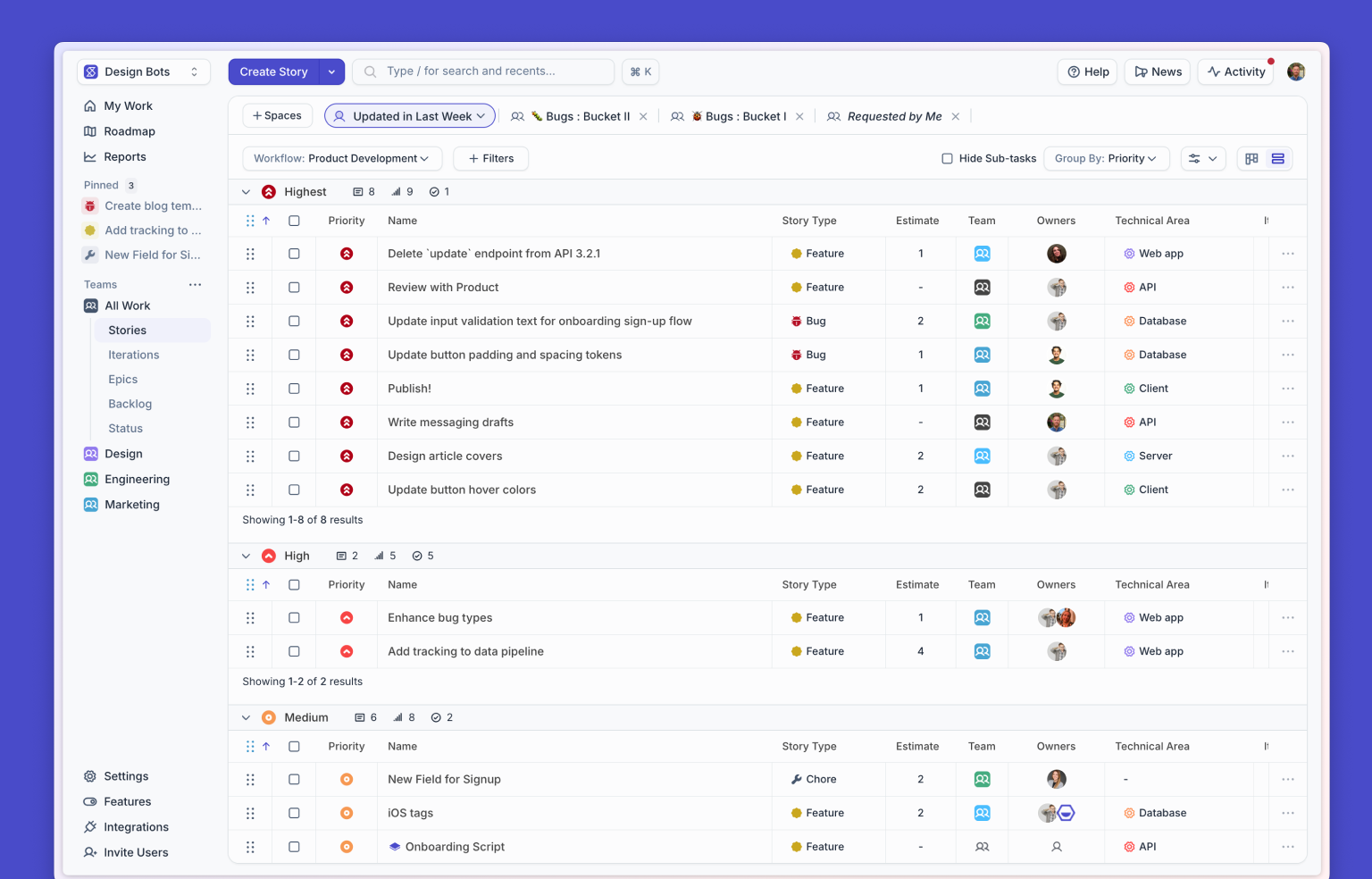Processes that work make people happy, as opposed to processes that don’t work, which make people unhappy. Agile product management works. This is a happy thing.
The best product managers are deeply involved in, quite naturally, product strategy. In fact, most great product managers are great because they are actually kind of obsessed with product management, obsessed with perfecting a product to get just the right market fit. In other words, to name just a few, they are obsessed with:
- Gathering user requirements
- Pinpointing problems and opportunities for product development
- Determining the right problems to address
- Coming up with product roadmaps and initial features
- Deciding which development tickets to prioritize
Think customer experiences, customer needs, business objectives, release planning, product requirements, metrics, functionality, new features, pricing, market research = product success.
Read More: Use Product Analytics to Improve User Experience
What is Agile Product Management?
Agile product management was born from agile software development methodologies, like scrum and kanban, which promote evolutionary development, early delivery, and continuous improvement as per the good ol’ Agile Manifesto.
Similarly, the goal of agile product management is to set product strategy and create product roadmaps in a way that endorses an adaptive and flexible approach to product planning and implementation so organizations can quickly and fluidly respond to feedback and build products that customers love.
Read More: The Product Manager’s Toolkit
Agile vs Waterfall: New vs Old
It's safe to say that the waterfall has been suspended, mid-stream - meaning that Agile has surpassed waterfall as the most popular product and project management methodology.
Agile methods focus on people and flexibility, waterfall hinges on process and documentation. The waterfall methodology focuses on rigorous development processes, only allowing PMs to move on to the next pre-planned step when the previous stage is fully complete. Because of this, projects using waterfall may take longer to develop or to pivot to end user feedback.
Where waterfall focuses on fully completing large chunks of a project in order, Agile emphasizes real-time feedback integration from stakeholders and customers by breaking projects down into smaller, workable pieces that can be changed at any time.
Agile is better suited for rapidly changing, feature-driven projects developed with small or mid-sized teams.
Read More: Key Skills for Growth Product Managers
Organizing Agile Teams at Product-Led Organizations
Managing product teams in an Agile environment is different from more old-school product development environments. Great product leaders recognize this and can position their teams for success with an intentional, thoughtful, fluid approach.
One significant difference between traditional settings and Agile workplaces is the pace. Once upon a time, a long, long time ago, there was time and space for lengthy reviews and iterations of documents and specifications, with change requests shopped around for signature approval and no one deviating from extremely detailed instructions without good reason and discussion.
That isn’t an option in an Agile environment, where entire sprints may only last a couple of weeks, and developers and engineers need answers and clarifications as soon as possible to get their deliverables included in the next release. This is why top-down, command-and-control management styles don’t jive with Agile.
Instead, product leaders must empower their team members to become decisive subject matter experts to interact directly with product development to hash out issues and reach a consensus without incurring delays. The process requires both trust and clear communication and alignment within the product team itself.
Delegating and entrusting team members to handle things independently is essential to creating a high-performing Agile product team. There isn’t the time or bandwidth for every decision to run up the chain of command to the department head, nor is that efficient use of everyone’s time. Nor does anyone like this, in general.
There should be an ongoing, open conversations between product leaders and their team members. Transparency creates awareness of those downstream decisions and ensure the entire team remains unified and aligned behind the current strategic goals while keeping users top of mind. Creating this culture is critical to success.
Read More: How to Build Trust Through Reporting
Product Managers vs Project Managers in Agile Methodology
Product managers set the product vision - the why and the what. As in, What’s the point of this product? Why would someone want to use this product? What problems are we solving?
Project managers worry about the who and when and how. They align the available resources and schedule to make it all happen as fast as possible. In some ways, transitioning to Agile can be more disruptive to project managers, who tend to go for predictability, routine, and schedules, than product management, rather than product managers.
These are two distinct roles, but within an Agile framework, there’s no formal handoff of the baton. Product managers don’t hand over a requirements document and walk away, leaving the rest up to the project manager. With Agile principles, product managers remain very much involved throughout the entire process. Their availability and interactions with the rest of the team are essential to producing valuable deliverables at a fast pace.
Now, sometimes, product managers try to come up with product ideas in a silo. This creates two problems:
- The ideas are limited by that one individual's capacity
- Getting buy-in from key partners in the development process is more difficult
This is why many engineers appear to resent product managers. They don't inherently understand the 'why' that led to the product ideas and so don't really care about building them. They're not bought in because no one cared about getting them to buy in.
At Shortcut, we believe in bringing together key stakeholders in Product Management, Product Design, and Engineering as early as possible. Using a simple 1-page 'MVP Ideation' document, this cross-functional team can collaborate on an idea, evolve it to something great, and ensure everyone is on board.
Read More: Project Management for Product Managers: What to Know
Agile Implementation at Product-Led Organizations
Product-led organizations thrive on a continual feedback loop. There may be projects, and those projects may be done at some point, but the products themselves are continually evolving living things. Accepting this reality and the understanding that there will always be another change, more capabilities to create, and additional customer challenges to solve is very important in Agile.
Sure, uncertainty and change are realities, as annoying as this fact can be for stakeholders who need to budget, allocate resources, and anticipate the future. But in a product-led organization operating in an Agile environment, there must be room to learn, grow, and adapt.
Agile also requires product management to divide and conquer. Once the product is large enough to have multiple development teams working independently, each team needs a product management counterpart as their point person.
Luckily, collaborative tools in the product stack can streamline things and create a more responsive and open environment.
Finding the Joy in Product Management: What it’s Like at Shortcut
High Stakes, But Everyone Shares Responsibility
Product Managers at Shortcut have a lot of responsibility. We make sure our customers are heard, that we’re moving in the right direction, and that we build high-quality and valuable products. However, at Shortcut, this is the whole team’s responsibility. We all share in the outcomes of each feature release, and we all share in the company’s success. Additionally, product managers at Shortcut work very closely with our counterparts in design and engineering. This means that from idea to delivery, every feature is a true collaboration. Shouldering the responsibility of outcomes together makes being a product manager feel far less burdensome and lonely.
A Proper Work-Life Balance Makes Both Work and Life Less Emotionally Taxing
We have high aspirations for the future of Shortcut, but we also balance our drive with rest. Work/life balance is a genuine priority for all employees at Shortcut. As in, people actually take their PTO. While we do move fast, having the assurance that we can rest when we need to means burnout at Shortcut is far less likely.
With Transparency, There is Less Bad News
Transparency is not only one of our core values, it is something we truly embrace. If you saw our internal slack, you’d see that almost all channels are public. That’s because we believe that everyone in the organization should have access to all the information around decision-making.
We also use this product called Shortcut (hey, that’s us!) to keep record of communications on prioritization and solutioning. Because of this, there are fewer surprises for stakeholders, which means fewer tough conversations, and everyone can follow along on the decision making that went into the work we prioritize as a company.
Staying on Everyone’s “Good Side”: Good People Make this Easy
Shortcut is full of good people with good sides. Another of our core values is to treat people right. We really take this seriously. If ever there is a disagreement on a decision, we work to find a path forward that everyone is comfortable with.
While we do work hard, we also make time for getting to know one another on a personal level (which is important, since we are a remote company). Maintaining good relationships is easy when everyone across the company is prioritizing empathy and kindness.
It’s Rewarding
While Product Management has its challenges, it is also incredibly rewarding. Nurturing a product from an idea to something that touches users, brings them joy, and makes their lives easier is incredibly fulfilling. So, even when the emotional and interpersonal challenges of product management feel daunting, delivering good products to the world that do good things makes it all feel worthwhile.
In the right work environment, and with the right tools, product management can be a joy. Even for those product managers out there who are actually fed up with product management.
Every year, more and more companies look to Agile to improve how they operate and iterate. What makes Agile interesting and… agile!… is that its core set of values can be interwoven and used alongside nearly any existing methodology.
There is no wrong way to do Agile as long as you have great product managers. Having great product managers is a happy thing. Give Shortcut a whirl and become happy by signing up for your free trial.

















%20(788%20x%20492%20px)%20(1).png)
.png)

